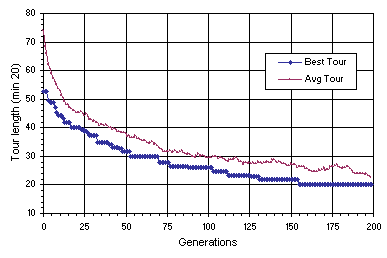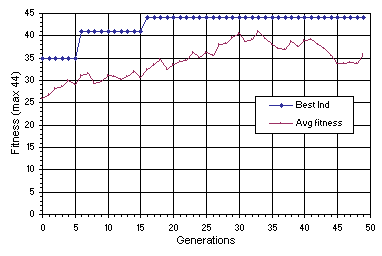We concluded the previous
chapter by analyzing the evolutionary dynamics of one of the most complex GEP systems – linearly encoded neural networks – and observed that GEP-nets exhibit exactly the same kind of evolutionary dynamics found in less complex genotype/phenotype systems.
As stated earlier in this chapter, the simple chromosomal organization used for combinatorial optimization is very similar to the canonical GA. Thus, it would be interesting to see if the evolutionary dynamics of these simpler GEP systems are also of the kind observed in GA’s populations.
Let’s first analyze the simplest GEP system in which only one multigene family is used per chromosome. Its evolutionary dynamics is shown in
Figure 6.7. Note that the evolutionary dynamics for this simple system is similar to the dynamics characteristic of GA’s populations. In those dynamics the plot for average fitness closely accompanies the plot for the best fitness and the oscillatory pattern on average fitness is less pronounced.

Figure 6.7. Evolutionary dynamics found in the simplest GEP systems. This dynamics was obtained for the first successful run of the experiment summarized in
Table 6.1 (traveling salesperson problem with 19 cities).
And finally, let’s analyze a slightly more complex system where chromosomes composed of two multigene families are used. The evolutionary dynamics shown in
Figure 6.8 was obtained for the first successful run of the experiment summarized in
Table 6.2. It is worth noticing that this evolutionary dynamics is no longer of the type expected for a GA. In fact, it has all the hallmarks of a GEP dynamics: the oscillatory pattern in average fitness and the considerable difference between the fitness of the best individual and the fitness of the average individual. Indeed, one should expect this kind of dynamics because of the higher complexity required to express chromosomes composed of two multigene families encoding complex interactions between their members.

Figure 6.8. Evolutionary dynamics of simple GEP systems. This dynamics was obtained for a successful run of the experiment summarized in
Table 6.2 (six-by-six task assignment problem). Note that, although simple, this system no longer exhibits a typical GA dynamics.
In the next chapter I will conduct a series of evolutionary studies, including the detailed analysis of the evolutionary dynamics typical of GEP populations. The aim of those studies is to discuss some controversial topics in evolutionary computation, most of them raised and intensified by the invention of gene expression programming itself.
|

